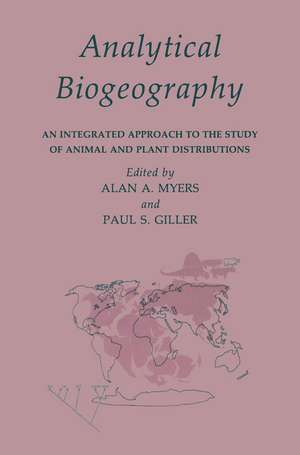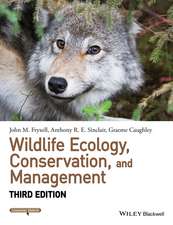Analytical Biogeography: An Integrated Approach to the Study of Animal and Plant Distributions
Autor Paul Gilleren Limba Engleză Paperback – 3 oct 2013
Preț: 654.95 lei
Preț vechi: 770.53 lei
-15% Nou
Puncte Express: 982
Preț estimativ în valută:
125.35€ • 130.52$ • 105.93£
125.35€ • 130.52$ • 105.93£
Carte tipărită la comandă
Livrare economică 07-21 martie
Preluare comenzi: 021 569.72.76
Specificații
ISBN-13: 9789401070331
ISBN-10: 9401070334
Pagini: 596
Ilustrații: XIII, 578 p. 10 illus.
Dimensiuni: 155 x 235 x 31 mm
Greutate: 0.82 kg
Ediția:Softcover reprint of the original 1st ed. 1988
Editura: SPRINGER NETHERLANDS
Colecția Springer
Locul publicării:Dordrecht, Netherlands
ISBN-10: 9401070334
Pagini: 596
Ilustrații: XIII, 578 p. 10 illus.
Dimensiuni: 155 x 235 x 31 mm
Greutate: 0.82 kg
Ediția:Softcover reprint of the original 1st ed. 1988
Editura: SPRINGER NETHERLANDS
Colecția Springer
Locul publicării:Dordrecht, Netherlands
Public țintă
ResearchCuprins
I Biogeographic Perspectives.- 1 Process, Pattern and Scale in Biogeography.- II Biogeographic Patterns.- 2 Biogeographic Patterns: A Perceptual Overview.- 2.1 Introduction.- 2.2 Patterns.- 2.3 Approaches to biogeography.- 2.4 Aims of biogeography: a question of levels.- 2.5 Pure biogeography: the biogeographical system.- 2.6 Levels, and their implications for historical patterns.- 2.7 Summary and conclusions.- 3 Species Diversity.- 3.1 Introduction.- 3.2 Definition and measurement.- 3.3 The patterns.- 3.4 Hypotheses.- 3.5 Evaluation of hypotheses.- 3.6 Conclusions.- 4 Relationship of Species Number To Area, Distance And Other Variables.- 4.1 Introduction.- 4.2 Description of the phenomena.- 4.3 Explanation of the species—area effect.- 4.4 The nature of environmental heterogeneity.- 4.5 The effect of other variables on the species—area.- 4.6 Consequences of the species—area effect.- 5 Endemism: A Botanical Perspective.- 5.1 Introduction.- 5.2 Biogeographical significance.- 5.3 A measure of endemism.- 5.4 Extent of and ecological variation in endemism.- 5.5 Endemism from various viewpoints.- 5.6 Endemism in contemporary biogeography.- 5.7 The future.- III Biological Processes in Biogeography.- 6 Adaptation.- 6.1 What is adaptation?.- 6.2 Species’ distributions.- 6.3 Comparisons among species.- 6.4 Mole rats — a transition to the genetic level.- 6.5 Variation within species.- 6.6 Adaptation and stressful environments.- 6.7 Conclusion.- 6.8 Summary.- 7 Speciation.- 7.1 Introduction.- 7.2 The nature of species.- 7.3 Modes of speciation.- 7.4 Biogeography and speciation.- 7.5 Conclusions.- 8 Extinction.- 8.1 Introduction.- 8.2 Diversity.- 8.3 Turnover.- 8.4 Biases affecting extinction patterns.- 8.5 Extinction patterns.- 8.6 Extinction susceptibility.- 8.7Extinction causes and processes.- 8.8 Conclusions.- 9 Ecological Interactions.- 9.1 Introduction.- 9.2 Background.- 9.3 Community characteristics.- 9.4 Species’ characteristics.- 9.5 Complementarities in species’ distributions and abundances: bridging the community and individual- species approaches.- 9.6 Conclusion.- IV Biogeographic Reconstruction.- 10 Refugia.- 10.1 Introduction.- 10.2 The Pleistocene rain forest refugia hypothesis.- 10.3 Testing strategies.- 10.4 Conclusions.- 11 Phylogenetic Biogeography.- 11.1 Introduction.- 11.2 Phylogenetic biogeography.- 11.3 Vicariance biogeography.- 11.4 Dispersal biogeography.- 11.5 Significance of fossils to biogeographic hypothesis.- 11.6 Conclusions.- 12 Cladistic Biogeography.- 12.1 Introduction.- 12.2 Cladistics and biogeography.- 12.3 Applications of cladistics to biogeography.- 12.4 Cladistic biogeography.- 12.5 Conclusions.- 13 Panbiogeography: Method and Synthesis in Biogeography.- 13.1 Space-time and biogeography: philosophical considerations.- 13.2 Panbiogeography and phylogeny.- 13.3 Spatial analysis in biogeography.- 13.4 Dispersal, vicariance and panbiogeographic models of Southern Hemisphere and New Zealand biogeography: a comparison.- 13.5 Conclusions.- 14 From Fossils To Earth History: Applied Historical Biogeography.- 14.1 Relevant parts of the biogeographical system and overview of methods.- 14.2 Constraints.- 14.3 Methods based on distributional change.- 14.4 Methods based on originations.- 14.5 Discussion.- 14.6 Conclusions.- 15 Experimental Island Biogeography.- 15.1 Introduction.- 15.2 An equilibrium theory.- 15.3 Implications of island biogeography theory.- 15.4 Summary.- References.











